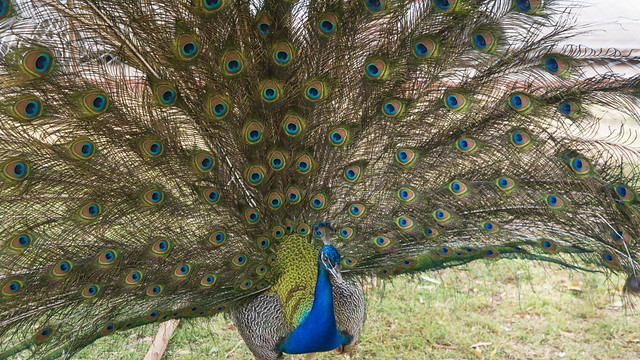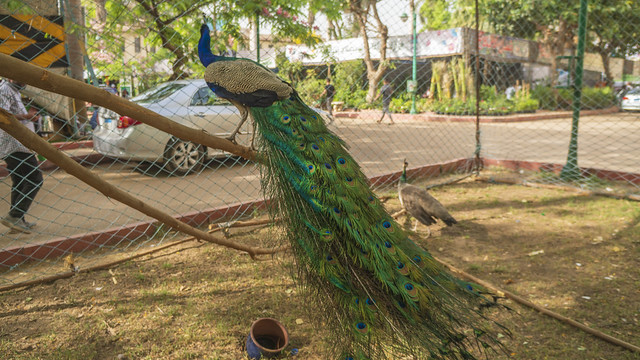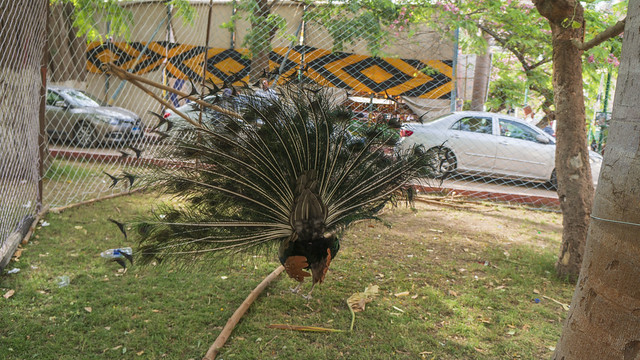It is not every day you can see a peacock; thus, I could not waste the opportunity to see that magnificent up and close.
As you have known from my post and quick camera tour at the Spring Flowers Fair 2023, there was a peacock and its female partner on display.
 |
| A peacock or Indian peafowl displaying his tail in action |
It was the first time for me to see a peacock in person alive in its magnificent glory. I have not seen a peacock alive at the Giza Zoo during my visits to the famous landmark currently in danger.
I have seen one taxidermized at Giza Zoo’s Zoological Museum.
 |
| A taxidermized Indian Peafowl at Giza Zoo's Zoological Museum |
The label read its official name in Arabic and English: Indian Peafowl.
Yes, its official name is Indian peafowl because that species originated originally from the Indian subcontinent specifically in modern-day India and Sri Lanka.
I am not embarrassed to admit that I did not know this fact.
It seems that Egypt’s Ministry of Agriculture borrowed the peacock or an Indian Peafowl and its female partner, the Peahen from the Giza Zoo along with his female partner, a peahen at this year’s edition of the Spring Flowers.
 |
| The peacock and peahen eating something |
I also did not know that the peacock’s female partner is named Peahen. The less attractive peahen is usually ignored compared to the beauty of her male.
Scientifically and realistically speaking, male birds are more colourful and more beautiful than their females.
It is their law of attraction.
Luckily it was mating season, and the male peacock was trying to impress his partner with his magnificent colourful tail thus humans had another free show of that tail in action.
 |
| A peacock or Indian peafowl displaying his tail in action |
The tail is amazing, and you can understand why the peacock became a symbol of royalty, especially in the East.
I can also understand how the ancient Greeks immortalized the tail of the peacock in their mythology in the sad tale of Argus Panoptes.
Interestingly according to some historical records, the Phoenician traders were the ones who introduced peafowls to ancient Egypt from 3000 years ago.
600 years later, Alexander the Great presented the peafowls to Greece and the West accordingly.
 |
| A peacock displaying its tail and its back too |
Other records say that ancient Egyptians knew peafowls in the time of the Ptolemaic era as they were brought along with the parrots to Egyptian markets for the wealthy to own them.
Anyhow enough of the ancient history.
Partially I feel that the peacock was displaying it for humans more than his partner as he is all the attention of those big humans.
 |
| A peafowl and its tail as well as out of focus peahen |
I felt that the peahen was not interested in humans, unlike the peacock who somehow gave me the impression that he understood that he was the center of attention inside that ugly pathetic cage.
The Peacock was irritated in the hot weather and was doing this movement with his neck as you can see in the video below. According to his guard, he does not to be touched by humans because he fears for his tail.
To be honest, after seeing it in person what really captured my eyes in the camera’s viewfinder was the tail but rather the magnificent blue colour of the bird’s body.
 |
| Peacock's blue body, neck and head crown too |
These vivid colours of blue and green are a wonder in their own way. Again, I totally understood why the peacock became a symbol of Royalty, especially with that tiny feather crown.
Now a little fact: The blue colour we see right now vividly in the photos is caused by the way that light interacts with the peacock's feathers.
 |
| Peacock's blue body, neck and head crown too |
The feathers have tiny structures that reflect blue light while absorbing other colours of light.
This is why the peacock's body appears blue, even though there is no blue pigment in the feathers. The only pigment in the body of that amazing bird is its brown feathers.
 |
| The brown feathers in the back of the peafowl |
This is called structural coloration and it was discovered by early scientists thanks to the peacock.
Sir Isaac Newton is often credited with discovering structural colouration in “The Book of Opticks”, but he was building on the work of Arab and Islamic scientists in the Golden Age.
One of the earliest mentions of structural colouration in the peacock was by Al-Biruni, a 10th- or 11th-century Persian polymath. In his book “The Book of Instruction in the Elements of the Art of Astrology”, Al-Biruni noted that the peacock's feathers are not actually blue, but rather that they appear blue due to the way that light interacts with the feathers.
 |
| Peacock's blue body, neck and head crown too |
He also discussed the peacock's iridescent colours, which are caused by the way that light is reflected by the tiny structures in the feathers.
Another Persian scientist who wrote about the peacock's colours was Ibn Sina, also known as Avicenna. Ibn Sina was a world-famous Persian polymath who wrote about the peacock's colours in his famous medical encyclopedia “The Canon of Medicine”.
He observed and recorded that the different colours of the peacock's feathers were associated with different medicinal properties. He used the peacock's example to illustrate the concept of using natural elements in medicine based on their specific characteristics and properties.
 |
| Peacock's blue body, neck and head crown too |
Alhazen, also known as Ibn al-Haytham, was a 10th or 11th-century Arab polymath who is the father of modern optics. He wrote about the peacock's colours in his book “The Book of Optics.”
Alhazen observed that the colours of the peacock's feathers are not inherent to the feathers but rather are the result of the interaction between light and the microscopic structure of the feather. This interaction causes light to scatter and interfere, resulting in the vibrant and iridescent appearance of the feather's colours.
 |
| Peacock's blue body, neck and head crown too |
There are other Muslim scientists who studied and mentioned the peacock, but the names above are the most famous who actually discovered structural colouration centuries before Sir Isaac Newton.
Anyhow here is also a video for this beautiful bird too.
I could not comment because I did not know what to say to describe this beautiful creature caged in an ugly makeshift dirty cage.

Beautifully written!
ReplyDeleteI did not read it the first few times that I found it, but you persisted and I thought it had to be very special for you to repeat posting! It is!